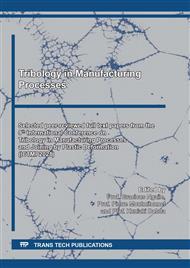p.33
p.39
p.45
p.51
p.59
p.69
p.75
p.81
p.89
Increasing and Decreasing Depth Taper Scratching: Force Response of Silicon
Abstract:
Mechanical loading and unloading of silicon is a characteristic feature of grinding and diamond turning processes. Such rapid loading and unloading induces damage and phase transformations. While, indentation tests are often used to study such normal loading and unloading via characteristic events in the force-depth plot, such tests involve only normal loading and lack tangential loading. A better alternative is scratch test, both constant and varying depth ones, involving normal and tangential loading on the scratching tool; this better simulates conditions of machining, or grinding. In this research, the mechanical load/unload behavior response of silicon is studied under scratching conditions by comparing increasing and decreasing depth scratch behaviour. In-situ force responses show that after ductile-brittle transition occurs, higher forces, at a given scratch depth, are required to deform the material during increasing depth scratching for a given depth than in decreasing depth scratch. Large surface and sub-surface damages with the presence of radial, median, and lateral cracks are seen to make the material weaker, ahead of the advancing tool, in decreasing depth scratch. Raman intensity ratio of amorphous silicon (a-Si) to nanocrystalline silicon (nc-Si) shows that high amorphization of silicon occurs during increasing depth scratching than decreasing depth. Using such force-depth plots an attempt is made to compare the normal loads while indenting and scratching. This study can help optimize the processing of silicon by grinding and diamond turning.
Info:
Periodical:
Pages:
59-65
Citation:
Online since:
February 2022
Authors:
Price:
Сopyright:
© 2022 Trans Tech Publications Ltd. All Rights Reserved
Share:
Citation:


